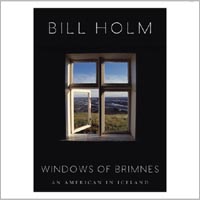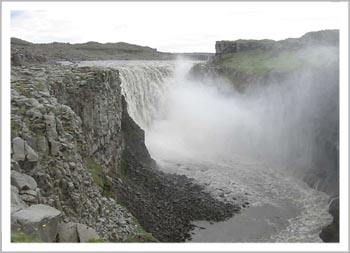By Connie Nardini
Who knew? Iceland is hot! At least it is according to one American, author Bill Holm, who has spent many summers there when he is not teaching English at a rural branch of the University of Minnesota. He fell in love with the island when he first brought a group of students there on a field trip. Being from heavily Scandinavian Minnesota, he already had the bona fides of coming from Icelandic stock. What he found was a place at once beautiful, mysterious and unique.
 Riddle: How many Icelanders does it take to change a light bulb? Holm would contend that the answer is no answer because Icelanders would not be able to agree on who should do the job. When he was interviewed about his The Windows of Brimnes: An American In Iceland by Garrison Keillor at a reading I recently attended in St. Paul, he testified that there are many Icelandic families whose members hardly speak to each other – they’re too stubborn to admit the other might be right. On the pro side, he finds the people of Iceland to be the best of neighbors to him at his home in Hofsos, Iceland, in a house he calls “Brimnes.”
Riddle: How many Icelanders does it take to change a light bulb? Holm would contend that the answer is no answer because Icelanders would not be able to agree on who should do the job. When he was interviewed about his The Windows of Brimnes: An American In Iceland by Garrison Keillor at a reading I recently attended in St. Paul, he testified that there are many Icelandic families whose members hardly speak to each other – they’re too stubborn to admit the other might be right. On the pro side, he finds the people of Iceland to be the best of neighbors to him at his home in Hofsos, Iceland, in a house he calls “Brimnes.”
One of the country’s charming customs is that all homes have proper names. In fact, everything has a name; often they reflect the world of fairy folk that seems to exist, still intact, just under the crust of the countryside. How about a church called Trollakirkja, which means “troll’s church,” or a pile of rocks named Trollasamlokur, a troll’s sandwich?
Of course, there is always the climate, which is not so good, especially in winter. But Icelanders have an answer to that as well: Because there’s often long stretches of winter darkness and gray fog, they prefer a certain bright, efflorescent quality in their house colors:
“An old man just atop the hill painted his small concrete house in stripes of orange and lavender. It matched the sunset well. He’s tamed it down now to blue and white, but I miss that gypsy touch.”
The view from Holm’s big front windows make up, however, for all the winter gloom. They face fjords, for example:
“Some fjords have narrow, dark mouths, Puritans who dare you to enter their inner space, rocks that eat an hour or two of daylight at either end of the day . . . [My] fjord is a fat fjord with a wide mouth open to all the light it can drink, even the last smidgeon it can suck out of the sun, or even the intense winter moon or the northern lights.”
Iceland is also a place where everyone is a poet. David Sefansson, a well-known poet in this land, loves the many ravens on the island – they are called Krummi because of their unlovely, croaky voices, their krak. Sefansson tells a story of a raven who wanted to sound as good as the other birds, but couldn’t.
Raven owns no lovely notes
Under his black cowl condemned to croak
Til his raven heart is broken –
But raven is my bird.
He croaks his song
To the sky and sun.
Icelanders are also born storytellers. Holm’s neighbor, Sverir Asgrimsson, told him a story from his childhood: He was overcome with loneliness at his isolated farm and tried to walk seven hours in the dark to the next farm.
“And the great silence and the heavy fog, and the wind blowing from all directions at once, and the crying of the gulls and gannets, and the sloshing of the cold, shark-rich sea in its last few miles before the ice takes over once and for all.”
The elves also live in Iceland. But, Holm says, these elves are not the cuddly “little people” of, say, the South Side Irish. Not ” . . . the cute felt and pottery Huldefulk in gift shops, nor the grotesque dwarves with buckteeth, big noses, silly grins and pointy toes. No, they are a mirror of us, what Jungians call a shadow self, or the interior life. The stories about them are not whimsy or fantasy, but rather coded messages – hidden wisdom – to be revealed to us when we exercise our ‘second sight’ . . . road construction crews are careful to avoid laying roadbeds through elf dwellings.”
Even though Icelanders are known to be logical and skeptical, they won’t take a chance on upsetting the elf world by carelessly destroying a rock that might bear the small ones’ mark in some way, say for instance by having a funny-looking crack or by being in a place traditionally known for harboring elves.

And near by Brimnes is a genealogy center where people visit form all over to find out about their ancestors who have fanned out across the world looking for a “better” place to live. You can type your name into a computer, which will tell you to “hold your horses” while it finds some facts (this is because Iceland is also famous for its powerful breed of sturdy work hoses raised on the island).
Holm is also a published poet. He likes to play Bach in his small living room and often invites friends and neighbors to play with him. He wrote the following poem called “Bach in Brimnes.”
The cello seems too big for this small room
But when he starts the saraband in G
The whole house grows too tiny for the tune
As if the walls were pressing to expand
Another fifty paces toward the sea
To make breathing space for all this sound,
If any human space we build could house
Whatever whirls around inside this suite.
Holm told Keillor that night that he couldn’t write fiction because “all my heroes have my opinions – all my villains speak with my voice.” His voice is often that of a cuttingly funny curmudgeon, ready to leave the hectic and sometimes crazy world of the USA for the silence of the fjords. Keillor, in his introduction of Holm, said he “is a sort of an iceman, someone who was buried in ice for centuries and we excavate him and we’re able to study him and see what authors used to be like. He’s one of the last of great 19th century writers.”
I don’t know about the 19th century part, but Holm is indeed a unique voice of canny and fascinating opinions about living in the 21st century. He has written about being in a teacher in China in Coming Home Crazy; a book of poetry, Playing the Black Piano; and many other poems, essays and travelogues.
He ends The Windows of Brimnes with a comment about the practice (or actually the non-practice) of Lutheranism in Iceland.
“Don’t come to the windows of Brimnes to pray – instead, lift your head to peer about, even into the heart of the fog. Take it all in; grandeur, foolishness, the whole lot. Sing. Maybe Bach, to lift the fog.”
–
Previously in Connie’s Corner:
* “Heavier Than Air.” Nona Caspers creates a tapestry of small towns and chronicles the lives of people living there who have a hard time coming down to earth.
* “Pale Fire.” Nabokov creates a novel that doesn’t seem to have coherent plot but a story that contains a do-it-yourself kit.
* “Out Stealing Horses.” A coming-of-age story that reveals a father’s secret life during wartime.
Posted on March 5, 2008


